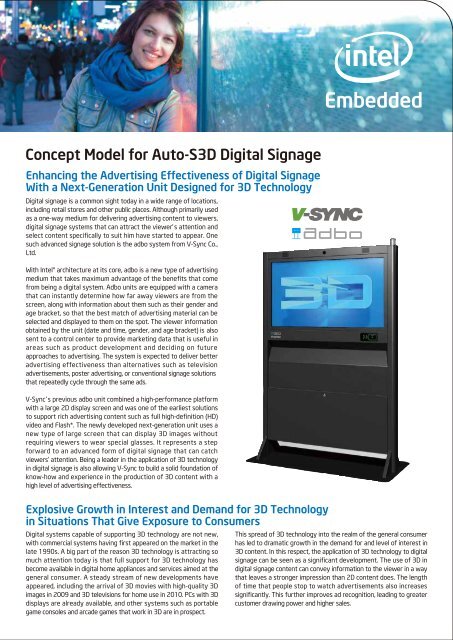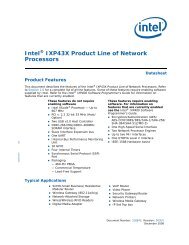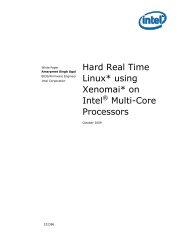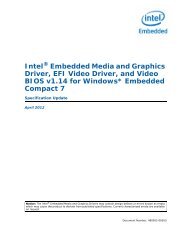Download - Intel
Download - Intel
Download - Intel
- No tags were found...
Create successful ePaper yourself
Turn your PDF publications into a flip-book with our unique Google optimized e-Paper software.
State-of-the-Art Naked-Eye Auto-S3D Display Used in Next-Generation adbo UnitThe next-generation adbo unit has a large screen that can display3D video. Unlike 3D TVs for the home, 3D digital signage must workwithout the need for special glasses because of the way in which itis used and the type of locations where it is installed. Accordingly,adbo uses VMJ Inc.'s VMJ Auto-S3D-Display System solution, whichdisplays 3D video in such a way that it can be viewed with thenaked eye. The VMJ Auto-S3D-Display System is based onnaked-eye 3D technology from 3D International Europe GmbH ofGermany (previously known as VisuMotion GmbH). Its key feature isthe ability to display crisp 3D content in locations such as offices orstores.The VMJ Auto-S3D-Display System creates convincing 3D imagesusing a parallax barrier that works by placing a special filter overthe LCD panel so that separate images are projected onto the leftand right eyes through a grid of slits. Although the parallax barriermethod is typically used for two-viewpoint display whereby onlyone image is produced for each eye, this is unsuitable for digitalsignage because the resulting sweet-spot for viewing the 3D videois too small. Instead, the VMJ Auto-S3D-Display System uses fiveimages to generate the 3D effect (five-viewpoint display). Bymaking the slits sufficiently narrow and arranging the images fromthe different directions in a continuous pattern, a realistic 3D imageis produced even if the viewer moves. This results in a wide120-degree viewing range and means that attractive 3D imagescan be viewed from various positions.Concept of Naked-Eye 3D TechnologyBGRBGRBGRBGRBGRBGRBGRBGR876543218765432187654321Display SurfaceRGBFilterRighteyeLefteyeNext-Generation adbo Unit Fitted WithHigh-Performance 2nd Generation <strong>Intel</strong>® Core i7 ProcessorThe adbo unit is housed in a dust-proof, waterproof case andincludes a controller for overall control of the unit, the Auto-S3Ddisplay and speakers used to deliver the advertisements, anon-contact IC unit for sending information to mobile phones, and anetwork connection module for data communications with thecontrol center. The controller uses a state-of-the-art hardwareplatform based on <strong>Intel</strong>® architecture, at the heart of which lies an2nd Generation <strong>Intel</strong>® Core i7 processor. 3D graphics are alreadywidely used in the realm of PCs and workstations in areas such as3D modeling and games, as well as in the attractive graphical userinterfaces (GUIs) adopted by operating systems in recent years.This has created a very high degree of affinity between PCs and 3Dtechnology, making the use of 3D content a logical step for digitalsignage based on <strong>Intel</strong>® architecture.
Sophisticated Software Made Possible Through Synergies With Windows* EmbeddedThe operating system (OS) used in the adbo units is Microsoft*Windows* Embedded Standard 7, which is optimized for embeddedsystems. The units take advantage of synergies between the latest<strong>Intel</strong> processors and Windows* Embedded to play rich advertisingcontent using formats such as 3D, Flash*, and full HD video, and toprovide highly interactive advertising delivery by combiningmechanisms such as cameras and non-contact ICs. The applicationthat implements the various signage functions, such as facialrecognition and content playback, runs on the OS. The sophisticatedfacial recognition used in adbo is further supported by V-Sync'sproprietary "scale sell" and "match sell" functions. The scale sellfunction detects the location of viewers in front of the adbo unitand selects what to display based on how far away they are.Similarly, the match sell function selects what to display based onthe viewer's gender, age bracket, and other characteristics. Theviewer detection, facial recognition, and other algorithms used inadbo have been enhanced compared to the previous model, and therecognition performance in the scale sell, match sell, and similarfunctions has been further improved.How adbo worksScale sellUsed to detect how far away the viewer is standing and select advertisements with an appropriate level of information content.Normal operationOutside facialrecognition rangeCamera detection rangeMain contentVideo is typically displayedover the full 46-inch screen.Distance from camera:Approx. 5mDistant(approximately 5m, depends on camera)Camera detection rangeSub-contentDisplays information suitablefor the age and genderof the passerby.Distance from camera:Approx. 2mCamera detection rangeNear(approximately 2m)Attention-grabbing contentIf someone approaches the unitto see more, it displays morepersuasive information.Match sell attribute recognitionThe unit determines the attributes (gender and age) of the viewer and selects what to display accordingly.Attribute recognitionFemale,20s or 30sAdvertisementaimedat womenin their20s or 30sAdvertisementaimedat womenin their40s or 50sAdvertisementaimedat menin their20s or 30sSelects whatto displaybased ongender and age.The camera in the adbo unit determines the gender and age of the viewerand displays advertisements suitable for their demographicin the sub-content area.PrioritizationViewersone male, four femalesTarget viewerfor advertisement30sBeeradvertisementaimed at menin their 30sAdvertisementaimedat womenin their40s or 50sAdvertisementaimedat menin their20s or 30sDisplayan advertisementsuitable forthe target viewer.30s 40s 50s 60sTarget viewerAdvertisements for different demographics can be prioritized andan advertisement directed at the target viewer.
<strong>Intel</strong>® Active Management Technology Supports Remote Monitoringand Administration of adbo UnitsAlthough adbo units are installed throughout Japan, tasks such astheir monitoring and administration are all handled centrally at acontrol center. The systems at the control center include a contentmanagement and distribution system, log collection and processingsystem, adbo unit monitoring system, and additional informationdistribution system. The adbo units can connect to the Internetusing mechanisms such as WiMAX* or 3G data communications tomaintain ongoing communications with these back-end systems.This all-encompassing system allows V-Sync to provide a one-stopservice covering everything from ad production to distribution andadministration. 3D content in particular can be produced efficientlyin partnership with VMJ technical staff using VMJ's own z.l.i.c.eproduction application and other tools.The adbo system was one of the first embedded systems productsto adopt <strong>Intel</strong>® Active Management Technology (<strong>Intel</strong>® AMT), whichis used to ensure the reliable performance of monitoring andadministration from the control center. <strong>Intel</strong>® AMT is an advancedtechnology for operation and management that can perform certainoperations independent of whether the OS is running, includingturning the power on and off, providing console access, or accessingthe hard disk drive (HDD). Whereas previous units without <strong>Intel</strong>®AMT required maintenance staff to visit the sites where units wereinstalled, <strong>Intel</strong>® AMT allows faults to be responded to remotely fromthe control center. This has made it possible for the adbo units toachieve availability levels of 99% or better and has provided amajor boost to the service level of this advertising medium. It alsoreduces administration costs and reduces the maintenance portionof the solution's total cost to among the lowest in the signageindustry.<strong>Intel</strong> Supports Ongoing Evolution of Digital Signage SolutionsDigital signage solutions that support 3D technology will continue toevolve in the future. For example, the technology is expected todevelop in the direction of fitting future units with veryhigh-resolution LCD panels featuring higher numbers of viewpointsto produce 3D images that are more attractive and easier to view.The dramatic increase in processing power needed to display 3Dvideo will create demand for microprocessors with even betterperformance. <strong>Intel</strong>® architecture is continually evolving through theapplication of advanced semiconductor manufacturing technologyand will go on comprehensively meeting the severe requirements ofthese next-generation systems.<strong>Intel</strong>, the <strong>Intel</strong> logo, <strong>Intel</strong> Core, and Core Inside are trademarks of <strong>Intel</strong> Corporation in the U.S. and other countries.*Microsoft, Windows, and the Windows logo are trademarks of the Microsoft group of companies. Other names and brands may be claimed as the property of others.<strong>Intel</strong>® Active Management Technology (<strong>Intel</strong>® AMT) requires the computer system to have an <strong>Intel</strong>® AMT-enabled chipset, network hardware and software, as well as connection with a power source and a corporatenetwork connection.This paper is for informational purposes only. This information is provided as iswith no warranty, express or implied. <strong>Intel</strong> assumes no responsibility for any errors contained in this document and has no liabilityor obligation for any damages arising from or in connection with the use of this document. The information here is subject to change without notice.Please note that, because the solutions and services of V-Sync Co., Ltd. are outside <strong>Intel</strong>s control, <strong>Intel</strong> offers no warranties regarding their performance.Copyright 2011 <strong>Intel</strong> Corporation. All rights reserved.324665-001ENJPN/1011/2000/CB/MKTG/YH
















